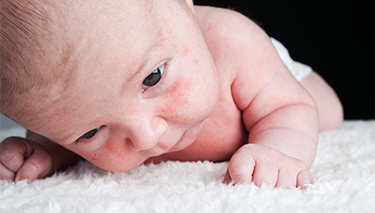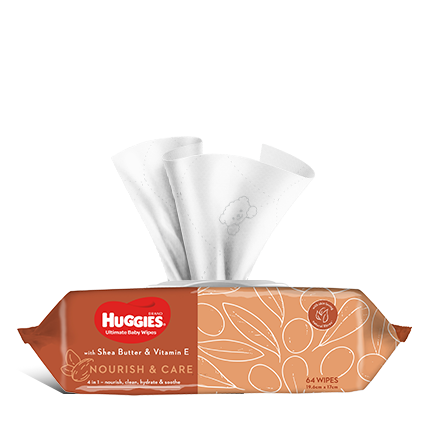Babies can develop skin rashes as early as the first few days of life, and they can appear for a number of reasons. In most cases of infant rash there is no cause for alarm. If, however, your baby seems unwell, has a temperature, is not feeding well or they are vomiting, it’s important they are seen by a doctor. Sometimes rashes are a sign of illness and it’s important your baby is examined to rule out any other causes.
Watch the video
Small rashes are common for a newborn's skin when they are adapting to life outside the womb. Rashes are generally a sign that a baby's skin is reacting to irritants or changes in their environment.
If your baby has a rash that causes discomfort, spreads to different areas, or does not fade over time, it's a good idea to see a doctor in case the rash is a sign of other health issues or needs specific treatment.
Some babies develop hives, also known as urticaria or baby hives , most commonly on their torso, arms, legs and throat. Hives tends to appear in clusters of weals which vary in size from small to large. In babies, hives can be triggered by an allergic reaction to food or medication, though also due to heat, stress and/or contact with animals and plants. Often, the cause for an outbreak of hives is unknown. Treatment for hives is based around avoiding the factors which trigger the reaction and where necessary, antihistamine medication. It's important your baby is examined by a doctor if they have a skin reaction which appears to be hives.
The majority of skin rashes are harmless and require very little treatment. Prevention, by avoiding irritants and skin dryness is often helpful. Some babies have particularly sensitive skin and are prone to eczema or other skin conditions.
Common signs of rashes
Rashes generally appear as red, raised lumps on the skin. Other types of a rash are:
- Blisters
- Red spots
- Swelling or welts
- Dry patches of skin
- Cracked or flaked skin
- Heat or itchiness
- Flushed cheeks
- Lesions
- Nappy rash
These signs can indicate anything from nappy rash, to eczema or impetigo. Our rash diagnosis guide and images can help to provide more information.
Rash diagnosis guide
Here's a closer look at some of the most common rashes, as well as ways to recognise and treat them.
Contact dermatitis
- Signs: small blisters on the skin, on the extremities, torso or face.
- Cause: continued exposure to an irritant found on clothing, detergent or food the baby may have been in contact with.
- Diagnosis: a doctor will be able to confirm suspected dermatitis by examining the area and asking about your baby may have been exposed to.
- Cure: removing the irritant is the first step. Without contact, rashes generally fade quickly. A doctor will be able to recommend creams or medication to relieve any discomfort.
Eczema (atopic dermatitis)
- Signs: dry, red, itchy patches of skin with small bumps, sometimes with clear discharge. Commonly found on the face and scalp though can also spread to the elbows, knees, hands and wrists.
- Cause: may be genetic or an allergic reaction to irritants, moisture, heat, or food.
- Diagnosis: A formal diagnosis for the cause of a rash can only be made by a doctor. Though sometimes the reason for a rash is obvious e.g., a nappy or heat rash.
- Cure: identify what is triggering the outbreaks and try to avoid these. Generally, good hygiene and dressing the baby in natural fibres which helps to avoid overheating is useful. Doctors can prescribe topical corticosteroid cream to help with itching and relieve the rash. Ongoing eczema may require frequent moisturising and avoiding eczema triggers .
Nappy rash
- Signs: small pink blisters similar to pimples, over the nappy area and lower stomach. Especially common in crevices and folds of skin.
- Cause: continued exposure to dampness, especially urine and faeces and potentially, a thrush infection.
- Diagnosis: Is made on appearance. A nappy rash caused by thrush can be itchy and irritating to the baby. It can also spread quickly between nappy changes.
- Cure: thorough cleaning and drying at every nappy change will support healing. Air your baby's nappy area daily, change them frequently and use non-irritating wipes or plain water to clean their skin. Try Huggies Baby Wipes to gently and effectively clean their nappy area. Apply a good quality barrier cream after cleaning your baby's skin. Warm this first between your fingers before generously smearing on. Nappy rash which is caused by a thrush infection needs an anti-fungal cream applied. Check your baby's mouth for white patches thrush tends to thrive in warm, moist areas. It's important to treat your baby's oral (mouth) thrush and nappy thrush at the same time if a yeast infection is present.
Heat rash
- Signs: tiny white or reddish bumps most commonly found on the trunk of the body. If left untreated, these bumps can become small, red blisters.
- Cause: if your baby is overheated, sweat ducts can become blocked with oil and bacteria on the surface of their skin can cause an infection.
- Diagnosis: this rash is so common that it is quite easy to identify from pictures. Seeking a medical opinion is advised if the rash does not fade with treatment.
- Cure: remove excess layers of clothing and wraps as often as possible and expose the rash to fresh, cool air whenever appropriate. Cooling baths can also help.
For more information on rashes, take a look at our nappy rash, eczema and dry skin pages.
Have your baby examined by a doctor if you are concerned.
Edited and reviewed by Jane Barry, Midwife and Child Health Nurse July 2021.


Last Published* May, 2024
*Please note that the published date may not be the same as the date that the content was created and that information above may have changed since.




















